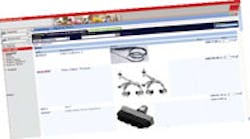If a purchasing agent needs a new supplier for a part, he doesn’t go to printed directories, he goes to Google and, in an instant, has more links than he can ever use.
If an engineer makes a design change, he doesn’t make a blueprint and mail it to his supplier, he attaches a copy of the change to an email, and in seconds his supplier has the new design.
When a machine shop owner/operator quotes a new part, the Internet can provide material prices and availabilities in seconds from multiple sources. Ten years ago, these activities were unusual, and many shops did not have websites. Today they are the norm in top shops, and most shops have a website that makes it visible in the marketplace. But, as powerful and useful as those abilities and websites are, they are only scratching the potential for the use of the Internet to increase shop productivity and profitability. The next step is to go to a web portal.
Company portals started gaining popularity in the 1990s, usually as intranets – Internets within a company. Unfortunately, the tools available to set up and maintain a portal were limited and Information Technology departments that tried to supply intranets often were inundated in user requests for broader access and customization that they could not fulfill.
The result was broad disenchantment with intranets. In the last few years, however, powerful tools and web portal application software has become available that makes it possible to deliver on the promise of a fully wired company.
Customers and employees can create and share documents of any file type without having technical Internet knowledge. Documents can be published immediately and can be opened for review and revision as needed.
Security and access are controlled completely through a single user login that identifies exactly the information a user can access and what – if anything – they can change.
Customers can be given permission to check order status, work in progress, project plans and invoices without having to wait for a shop’s employee to answer the phone and lookup the information.
The entire customer order workflow from request for quote to delivery followup can be automated, and can be easily programmed to give complete real-time visibility to anyone who is authorized to see it.
And, the benefits of a web portal don’t stop at customer order processing.
Most Human Resource departments spend a significant amount of time to keep employee records current. A portal can give employees controlled access to their information, and can enable them to keep it updated without burdening a Human Resources department.
Frequently asked questions can be posted and made available to employees 24/7 along with updates, changes and notifications.
Vacation requests, expense reports and timekeeping records all be can updated by employees and processed through an automated system to reduce the amount of time, effort, and cost, needed to process that information.
Partners can be given access to shop information to help them to schedule their work and deliveries based on actual realtime shop needs.
Invoices can be submitted and tracked without requiring timeconsuming contact with shop employees, and bottlenecks in work or material flow or other production and delivery problems can be easily made visible.
There are several powerful web portal application packages.
Microsoft’s SharePoint Portal Server and Oracle Corp.’s Web Center Suite are two of the most popular. But there are also web portal software packages on the market that focus on companies in a particular industry or of a particular size.
The Synergy Enterprise package from Exact Software North America (www.exactamerica.com), the makers of JobBoss jobshop control software, is one example.
It is not necessary to have JobBoss software to use Exact’s Synergy web portal management software, but it helps.
Examples of what is possible using a web portal package such as Synergy are:
- Every aspect of customer relationship management (CRM) can be centralized around customers and prospects.
- Document management can be enhanced to retain business knowledge on a constant basis across the organization.
- Human resource management can be develop with security, roles and rules- based access.
- Project management can be conducted seamlessly, and budgets, resources, documents and tasks can be connected directly to projects.
- Real-time reporting and analysis for all shop and office operations can be done for informed operational decision making.
- Manual and unsecured processes can be replaced to increase workflow and operational efficiency.
- Employees, suppliers, resellers and customers can be given access to critical business information through portals, so they can view that information at any time and from any remote location.
The software has caught up with the need.
Where IT departments were overrun with seemingly impossible requests 10 years ago, today the software makes connecting and customizing simple and flexible. At the same time the cost of the software has dropped to a range that makes it cost effective for any shop to purchase and install it.
Shop operators often are willing to invest in machines and tooling because they can see that those investments make money.
The software used to control a shop often doesn’t have the same obvious payback that machines and tooling do, but it is the control software, and in this case the web portal software, that enables a shop operator to extract maximum profit and productivity from everything done in and for the shop by everyone associated with that shop – employees, customers, suppliers and other business partners.
Now is the time to look into web portal software because it has finally come of age and offers a lot of bang for the buck.








